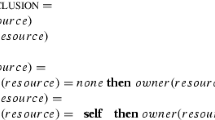Abstract
We describe our work in progress on μACL, a light implementation of the language ACL (A synchronous Communications in Linear Logic) for concurrent and distributed linear logic programming. Our description for computing elements (Agents) is inspired by the Actor model of concurrent computation. The essential requirements for Agent programming (communication, concurrency, actions, state update, modularity and code migration) are naturally expressed in μACL. Also, we describe some considerations towards the implementation of a distributed virtual machine for efficient execution of μACL programs.
Preview
Unable to display preview. Download preview PDF.
Similar content being viewed by others
References
Gul Agha. Concurrent Object-Oriented Programming. Communications of the ACM, 33(9), September 1990.
Abdullah-Al Amin. Agent-Oriented Programming in Linear Logic. Master’s thesis, RMIT University, Melbourne Australia, 1999.
Jean-Marc Andreoli and Remo Pareschi. LO and behold! Concurrent structured processes. In Proceedings of OOPSLA’90, pages 44–56, Ottawa, Canada, October 1990. Published as ACM SIGPLAN Notices, vol.25, no.10.
Giorgio Delzanno. Logic and Object-Oriented Programming in Linear Logic. PhD thesis, Universitá di Pisa-Genova-Udine, 1997.
Stephen J. Hartley. Concurrent Programming: the Java Programming Language. Oxford Univ. Press., 1998.
Peter Henderson. Functional Programming: Application and Implementation. Prentice/Hall International, 1980.
Joshua S. Hodas. Lolli: An extension of λprolog with linear context management. In D. Miller, editor, Workshop on the λProlog Programming Language, pages 159–168, Philadelphia, Pennsylvania, August 1992.
Naoki Kobayashi and Akinori Yonezawa. ACL — a concurrent linear logic programming paradigm. In D. Miller, editor, Proceedings of the 1993 International Logic Programming Symposium, pages 279–294, Vancouver, Canada, October 1993. MIT Press.
Naoki Kobayashi and Akinori Yonezawa. Reasoning on actions and change in linear logic programming. Technical Report 23, University of Tokyo, 1993.
Naoki Kobayashi and Akinori Yonezawa. Asynchronous communication model based on linear logic. Formal Aspects of Computing, 3:279–294, 1994.
Naoki Kobayashi and Akinori Yonezawa. Higher-order concurrent linear logic programming. In Proceedings of Theory and Practice of Parallel Programming (TPPP’94), Sendai, Japan, Lecture Notes in Computer Science, 1994.
M. Masseron, C. Tollu, and J. Vauzeilles. Generating plans in Linear Logic I: Actions and proofs. Theoretical Computer Science, 113(2):349–371, 1993.
Naoyuki Tamura and Yuko Kaneda. Extension of WAM for a linear logic programming language. In T. Ida, A. Ohori, and M. Takeichi, editors, Second Fuji International Workshop on Functional and Logic Programming, pages 33–50. World Scientific, Nov. 1996.
David Ungar and Randall B. Smith. Self: the Power of Simplicity. Lisp and Symbolic Computation, 1991.
G. Graham White. The Design of a Situation-Based Lygon Metainterpreter: I. Simple Changes and Persistence. Technical Report 729, Department of Computer Science, Queen Mary and Westfield College, University of London, 1996.
Author information
Authors and Affiliations
Editor information
Editors and Affiliations
Rights and permissions
Copyright information
© 2002 Springer-Verlag Berlin Heidelberg
About this paper
Cite this paper
Palacios, J.J. (2002). Flexible Agent Programming in Linear Logic. In: Coello Coello, C.A., de Albornoz, A., Sucar, L.E., Battistutti, O.C. (eds) MICAI 2002: Advances in Artificial Intelligence. MICAI 2002. Lecture Notes in Computer Science(), vol 2313. Springer, Berlin, Heidelberg. https://doi.org/10.1007/3-540-46016-0_27
Download citation
DOI: https://doi.org/10.1007/3-540-46016-0_27
Published:
Publisher Name: Springer, Berlin, Heidelberg
Print ISBN: 978-3-540-43475-7
Online ISBN: 978-3-540-46016-9
eBook Packages: Springer Book Archive




